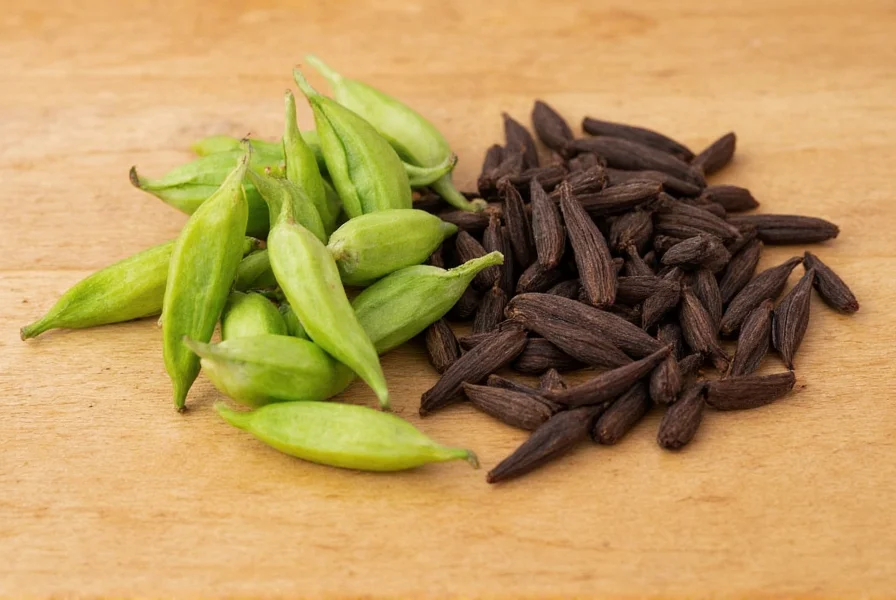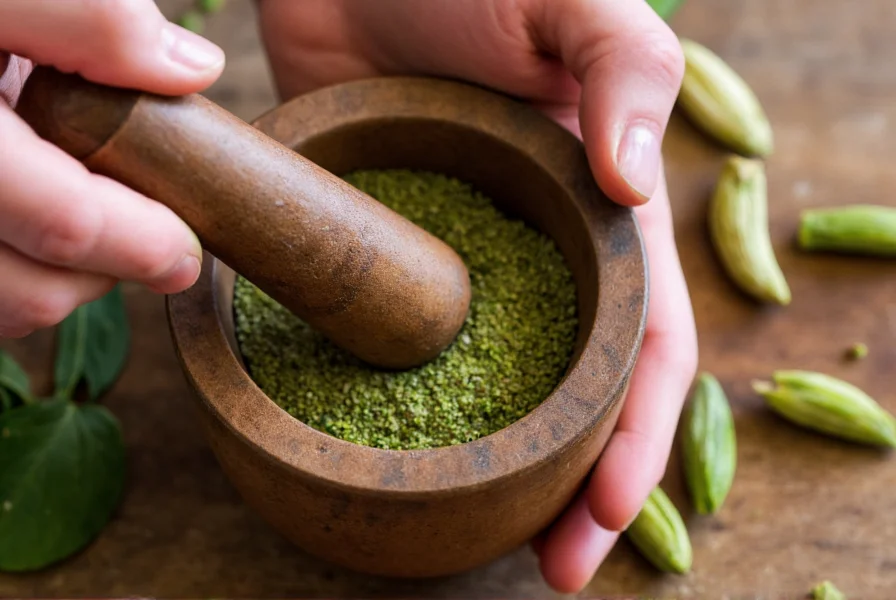Cardamom’s distinctive flavor and versatility have earned it a revered position in global spice traditions. As one of the world’s most expensive spices by weight—second only to saffron and vanilla—its value stems from the labor-intensive harvesting process where pods must be hand-picked before they fully ripen. Understanding this remarkable spice requires examining its varieties, applications, and proper handling techniques.
Types of Cardamom: Green vs Black

Two primary varieties dominate culinary applications:
| Characteristic | Green Cardamom | Black Cardamom |
|---|---|---|
| Botanical Name | Elettaria cardamomum | Amomum subulatum |
| Flavor Profile | Citrusy, floral, herbal with eucalyptus notes | Smoky, camphorous, earthy |
| Primary Use | Sweet dishes, beverages, rice dishes | Robust savory dishes, stews, braises |
| Processing | Air-dried without heat | Smoke-dried over open flames |
| Geographic Origin | India, Guatemala, Sri Lanka | Nepal, Bhutan, North India |
Green cardamom, the more common variety found in Western supermarkets, delivers a bright, complex flavor that enhances both sweet and savory dishes. Its delicate aroma makes it ideal for baking, chai tea, and Scandinavian pastries. Black cardamom, with its intense smokiness, serves as a foundational spice in Indian curries and Chinese five-spice powder. Never substitute one for the other in recipes requiring precision, as their flavor profiles differ dramatically.
Culinary Applications and Pairing Suggestions
Professional chefs and home cooks value cardamom for its remarkable versatility. When using whole pods, lightly crush them to release essential oils before adding to dishes. For ground cardamom, freshly grind seeds just before use to preserve volatile compounds that degrade quickly.
Consider these expert pairing recommendations for maximizing cardamom’s potential in your cooking:
- Sweet applications: Combine with orange zest in cake batters, infuse in poaching liquid for pears, or blend with chocolate in ganache
- Savory dishes: Add whole pods to rice pilafs, incorporate into spice rubs for lamb, or include in tomato-based curries
- Beverages: Steep in hot milk for cardamom lattes, infuse in syrups for cocktails, or add to mulled wine blends
When substituting ground cardamom for whole pods, use 1/4 teaspoon of ground spice for each pod called for in a recipe. For authentic Middle Eastern coffee, use one crushed pod per cup. Scandinavian bakers traditionally include cardamom in sweet breads at a ratio of 1 teaspoon ground cardamom per 3 cups of flour.
Health Benefits Supported by Research
Traditional medicine systems have utilized cardamom for centuries, and modern science increasingly validates many of these applications. Current research indicates several evidence-based health benefits:
A 2022 meta-analysis published in the Journal of Ethnopharmacology found that cardamom consumption significantly reduced oxidative stress markers in human subjects. The spice contains high concentrations of cineole, a compound demonstrating antimicrobial properties against common foodborne pathogens. Additionally, cardamom’s magnesium content supports cardiovascular health by promoting healthy blood pressure levels.
For digestive health, cardamom stimulates bile production which aids fat digestion. A clinical trial documented in Nutrition Research showed that participants consuming cardamom tea experienced reduced symptoms of indigestion compared to placebo. However, individuals taking blood-thinning medications should consult their healthcare provider before consuming large quantities, as cardamom contains coumarin compounds.
Selection, Storage, and Preparation Techniques

Maximizing cardamom’s flavor potential requires proper selection and storage:
- Selection criteria: Choose plump, olive-green pods that feel heavy for their size. Avoid yellowed or cracked pods which indicate age and flavor loss
- Storage methods: Keep whole pods in airtight containers away from light and heat. Properly stored, they maintain potency for 9-12 months versus 3-6 months for pre-ground spice
- Preparation techniques: For optimal flavor release, lightly crush pods with the flat side of a knife before use. To extract seeds, twist pods open and scrape out black seeds
When grinding cardamom, use a dedicated spice grinder as its essential oils can linger and affect other spices. For baking applications, combine cardamom with complementary spices like cinnamon and cloves at a ratio of 2:1:1 for balanced flavor without overwhelming dominance.
Cultural Significance Across Global Cuisines
Cardamom’s journey through culinary history reveals fascinating cultural adaptations. In ancient Egypt, it featured in tooth-cleaning mixtures, while Vikings transported it from Constantinople to Scandinavia where it became essential in lussekatter buns. Indian cuisine employs cardamom in both sweet kheer puddings and savory biryani rice dishes, demonstrating its remarkable versatility.
Arabian coffee culture centers around cardamom-infused brews, where freshly ground beans meet crushed pods in a ritualistic preparation process. In Southeast Asia, black cardamom forms part of the foundational spice blend for rendang, the slow-cooked beef dish that recently ranked as the world’s most delicious food by CNN Travel.
Common Cardamom Substitutes
When cardamom isn’t available, consider these alternatives based on your recipe’s requirements:
- For sweet dishes: A blend of equal parts cinnamon, nutmeg, and coriander (use 3/4 teaspoon substitute per 1 teaspoon cardamom)
- For savory applications: Allspice combined with a pinch of cloves (use 1/2 teaspoon substitute per 1 teaspoon cardamom)
- Closest flavor match: Equal parts ground cardamom and cumin for Middle Eastern dishes
Remember that no substitute perfectly replicates cardamom’s unique flavor profile. When possible, seek out specialty markets for fresh, high-quality cardamom rather than relying on substitutes.
Frequently Asked Questions
What’s the difference between green and black cardamom?
Green cardamom (Elettaria cardamomum) features a bright, citrusy flavor ideal for sweet dishes and beverages, while black cardamom (Amomum subulatum) offers a smoky, earthy profile suited for robust savory dishes. Green pods are air-dried, preserving delicate floral notes, whereas black cardamom undergoes smoke-drying that creates its distinctive campfire-like aroma. They’re not interchangeable in recipes requiring precision.
How can I tell if my cardamom has gone bad?
Fresh cardamom pods should feel heavy and emit a strong aroma when crushed. Signs of deterioration include faded color (yellowing pods), lightweight feel, and diminished fragrance. Properly stored whole pods maintain quality for 9-12 months, while ground cardamom loses potency within 3-6 months. Always check expiration dates and store in airtight containers away from light and moisture.
Can I use cardamom in coffee?
Absolutely. Cardamom complements coffee beautifully, particularly in Middle Eastern preparations. Add one crushed pod per cup of coffee grounds before brewing, or include ground cardamom in your coffee blend at a ratio of 1/4 teaspoon per 2 tablespoons of coffee. For traditional Arabic coffee, cardamom is essential—typically one pod per serving, sometimes combined with saffron or cloves.
Is cardamom safe during pregnancy?
Cardamom consumed in typical culinary amounts (1-2 pods daily) is generally considered safe during pregnancy. However, medicinal quantities (more than 3 grams daily) may stimulate uterine contractions. Pregnant women should consult their healthcare provider before using cardamom supplements or consuming large quantities. The spice’s digestive benefits can help alleviate morning sickness for some women when used moderately.
What’s the best way to grind cardamom?
For optimal flavor, grind cardamom seeds immediately before use. First, twist open pods and scrape out black seeds. Use a dedicated spice grinder or mortar and pestle for best results. If using a coffee grinder, run it with a few rice grains first to remove residual oils from previous grinding sessions. Never grind whole pods as the fibrous husks create an unpleasant texture in finished dishes.










 浙公网安备
33010002000092号
浙公网安备
33010002000092号 浙B2-20120091-4
浙B2-20120091-4